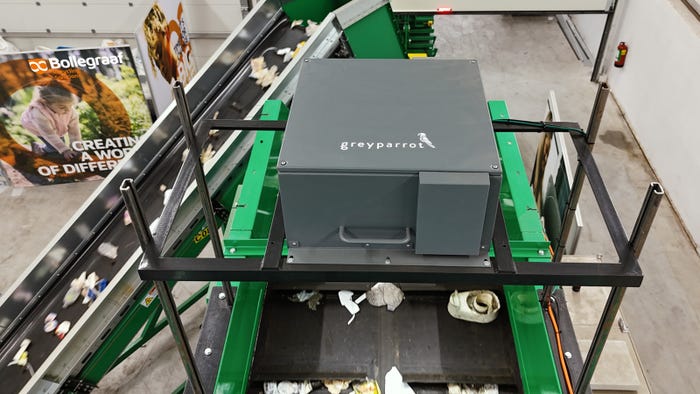AI-Driven Smart Recycling Is Here
Thousands of recycling facilities will use artificial intelligence to boost the recovery of recyclable packaging in more than 70 waste categories.

At a Glance
- Greyparrot and Bollegraaf strike a $12.8 million deal to install AI waste-analytics systems in thousands of MRFs
- The technology will provide detailed information about each waste item, including brand and GHG emissions
- Plastics producers, packaging manufacturers, and brand owners will benefit from AI-informed waste sorting and recycling
A strategic partnership between Greyparrot and Bollegraaf stands poised to help materials recovery facilities (MRFs) and plastics recovery facilities (PRFs) improve waste sorting and recovery through the power of artificial intelligence. Greyparrot specializes in AI waste analytics, and Bollegraaf builds recycling plants worldwide.
Through the partnership, Bollegraaf will transfer its AI vision business to Greyparrot and make a cash investment in that company, for a total value of $12.8 million. Greyparrot will acquire Bollegraaf’s AI development team and vision-based computing intellectual property.
Bollegraaf will become the worldwide distributor and a strategic partner for Greyparrot Analyzer, a waste-analytics tool that uses AI cameras to provide visibility into the composition of waste streams. The tool currently is used at recycling plants in 14 countries and in six US states.
The partners plan to retrofit thousands of existing MRFs and PRFs with Greyparrot Analyzer and to install the systems in new sorting facilities, as well.

GREYPARROT
How the AI smart sorting technology works.
When installed above waste streams within sorting facilities, Greyparrot Analyzer can identify materials in milliseconds. For items in more than 70 waste categories, the technology provides seven layers of data, including the waste item’s financial value, brand, and estimated greenhouse emissions.
Capturing detailed information about each piece of waste via an AI-based vision system will enable sorting facilities to boost recycling rates, diverting recyclable waste away from landfill, incinerators, and the ocean.
The retrofitted sorting facilities will also become more efficient and profitable, and more recyclable plastics will be available for mechanical or chemical recycling and, ultimately, reuse.
In 2023, Greyparrot analyzed more than 25 billion waste objects, funneling 70,000 tons of materials back into the circular economy. Subsequent savings for the sorting facilities ranged from hundreds of thousands to millions of dollars.
For plastics producers, the Greyparrot/Bollegraaf partnership is “a major step forward in ‘closing the loop’ by making it easier to recycle and reuse plastic products without material loss, thereby using fewer raw materials and reducing waste,” says Ambarish Mitra, co-founder of Greyparrot.
“With this announcement, Greyparrot Analyzer units will be deployed at scale across the US and the globe. As a result, and with this newfound waste intelligence, we’ll be able to provide much more data to producers, waste managers, and regulators, providing critical insights that enable improved sorting, recycling rates, and accountability throughout the lifecycle of plastic products,” Mitra adds.
Benefits of waste analytics for brand owners.
The availability of real-world waste analytics will provide several benefits to brand owners. By working directly with MRFs, PRFs, and recycling facilities, they will find out what really happens to their packaging, down to the stock-keeping unit, at end of life.
Brand owners will be able to use the analytics to make packaging design and materials decisions and create more sustainable, recyclable packaging — and to back up their sustainability claims with consumers and regulators.
Waste analytics are also useful for extended producer responsibility (EPR) and environmental, social, and governance (ESG) reporting, and for compliance with the new wave of legislation aiming to reduce plastic waste and boost recycling rates, such as California’s SB 54.
An advanced-recycling use case.
Greyparrot Analyzers are typically used to analyze waste in sorting facilities, but the technology can add value in recycling plants, including advanced (chemical) recycling facilities, as well.
“Although Greyparrot Analyzers were built with sorting facilities in mind, the technology can be applied in other scenarios,” Mitra says. “Take, for instance, Greenback’s flexible film recycling plant in Mexico, which uses innovative Enval pyrolysis units that convert flexible films into recycled polymer oil. It currently uses Greyparrot’s AI-powered Analyzer to evaluate incoming plastic waste to certify the quality of their recycled polymer oil."
By using AI technology for this application, Greenback boosts the quality and market value of its recycled polymer oil and can tailor feedstock blends to meet specific customer requirements.
About the Author(s)
You May Also Like




